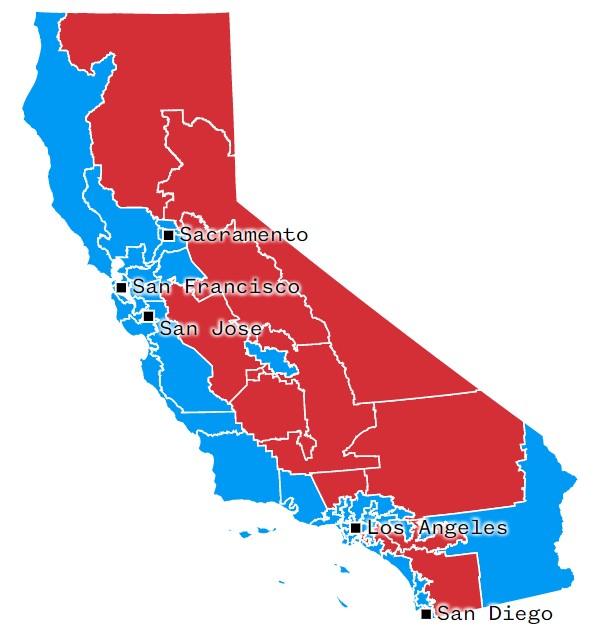CaliforniaŌĆÖs Political Evolution: From Conservative Roots to Progressive Leadership
California, historically recognized as a conservative bastion that produced influential figures like Richard Nixon and Ronald Reagan, has experienced a remarkable political metamorphosis over recent decades. This state, once emblematic of Republican dominance, has emerged as a progressive powerhouse, shaping national policy debates and redefining the Democratic PartyŌĆÖs priorities. The transformation is largely driven by sweeping demographic shifts, rapid urban growth, and the ascendancy of diverse social movements advocating for climate action, social justice, and economic fairness. The influx of younger voters and immigrant communities has been pivotal in reshaping CaliforniaŌĆÖs political ethos.
Several critical elements underpin this political realignment:
- Increasing demographic diversity: The rise of Latino, Asian, and other minority populations has significantly influenced electoral priorities.
- Urban expansion: Growth of liberal-leaning metropolitan centers such as Los Angeles, San Francisco, and San Diego.
- Centers of education and innovation: Universities and technology industries have nurtured progressive social and economic perspectives.
- Environmental leadership: CaliforniaŌĆÖs pioneering climate policies have set benchmarks for the nation.
| Time Period | Dominant Political Orientation | Prominent Leaders |
|---|---|---|
| 1950s-1970s | Conservative | Richard Nixon, Ronald Reagan |
| 1980s-1990s | Mixed | George Deukmejian, Pete Wilson |
| 2000s-Present | Progressive | Jerry Brown, Gavin Newsom |
Demographic Transformation and Its Influence on CaliforniaŌĆÖs Voting Patterns
The dramatic political shift in California is inseparable from its evolving demographic composition. The stateŌĆÖs electorate, once predominantly white and conservative, now reflects a rich tapestry of ethnicities, cultures, and generations, profoundly impacting party allegiance and voting behavior. Key demographic trends include:
- Expansion of Latino and Asian communities: Together, these groups constitute nearly half of CaliforniaŌĆÖs population, prioritizing issues such as immigration reform, education, and social equity.
- Urbanization and economic diversification: Metropolitan areas like San Francisco, Los Angeles, and San Diego have become magnets for younger, progressive professionals in technology, entertainment, and service sectors.
- Generational shifts: Millennials and Generation Z, characterized by greater diversity and progressive values, now form a substantial portion of the electorate.
The table below highlights the changing ethnic composition of CaliforniaŌĆÖs voting population from 1980 to 2020, illustrating the profound demographic realignment that has influenced political outcomes.
| Ethnic Group | 1980 Voting Population (%) | 2020 Voting Population (%) |
|---|---|---|
| White | 75% | 36% |
| Latino | 10% | 38% |
| Asian | 5% | 15% |
| Other | 10% | 11% |
How Policy Innovation Has Solidified CaliforniaŌĆÖs Progressive Identity
CaliforniaŌĆÖs political realignment is closely linked to its trailblazing approach to policy-making. The state has consistently pioneered reforms in areas such as environmental protection, healthcare accessibility, and voting rights, often preceding national trends. This proactive stance has fostered a feedback loop where progressive policies attract and energize a diverse electorate, which in turn supports further ambitious legislation aimed at addressing social inequities and climate challenges. CaliforniaŌĆÖs role as a policy incubator has had ripple effects across the country, influencing Democratic strategies nationwide.
Noteworthy legislative achievements include:
- California Voting Rights Act (2001): Enhanced minority representation by reforming electoral districting.
- Early adoption of Affordable Care Act expansions: Broadened healthcare coverage ahead of many other states.
- Cap-and-Trade Program: Market-based mechanism incentivizing reductions in greenhouse gas emissions.
- Sanctuary State policies: Legal protections for undocumented immigrants against federal enforcement.
| Policy | Year Enacted | Significance |
|---|---|---|
| California Voting Rights Act | 2001 | Boosted electoral participation among minority groups |
| Global Warming Solutions Act | 2006 | Achieved a 25% reduction in statewide carbon emissions |
| Affordable Care Act Expansion | 2014 | Increased healthcare coverage by 20% |
Insights from CaliforniaŌĆÖs Political Journey for the National Stage
CaliforniaŌĆÖs political transformation offers a compelling case study in how demographic evolution, innovative governance, and economic shifts can reshape a stateŌĆÖs ideological landscape. From its conservative origins, the state has become a beacon of progressive values through strategic urban development, environmental stewardship, and social investment. Central to this shift is CaliforniaŌĆÖs embrace of diversity and the growing influence of younger, more inclusive generations who prioritize climate action, healthcare access, and social justice.
For policymakers across the United States, CaliforniaŌĆÖs experience provides valuable lessons in coalition-building and adaptive leadership. Key takeaways include:
- Engaging immigrant populations as active participants in the political process.
- Leveraging technology and innovation to enhance public services and civic engagement.
- Implementing progressive policies that also promote economic growth and sustainability.
| Policy Area | CaliforniaŌĆÖs Strategy | Outcomes |
|---|---|---|
| Climate Change | Ambitious emissions reduction targets and incentives for renewable energy | Nation-leading decrease in carbon footprint |
| Social Equity | Reforms in criminal justice and affordable housing programs | Enhanced living standards in diverse urban communities |
| Economic Development | Support for tech innovation and green industries | Strong job creation and sustained economic growth |
Conclusion
CaliforniaŌĆÖs journey from a conservative stronghold to a progressive leader encapsulates the dynamic nature of American politics. Its diverse electorate and forward-thinking policies continue to influence national conversations, offering a blueprint for future political realignments. Understanding this transformation sheds light on the evolving ideological currents shaping the United States and provides a glimpse into the potential trajectory of American political discourse in the years ahead.







